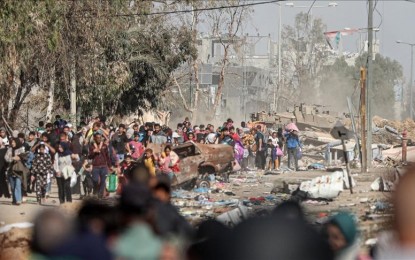An initial 10 hostages expected to be released followed by 50 Palestinian women and children
Palestinian and Israeli officials have published the names of 300 Palestinian women and children held in Israeli prisons, at least some of whom are expected to be released in an exchange with Hamas in Gaza for dozens of Israeli hostages seized by the militant group on 7 October.
A four-day pause in hostilities in the six-week-old war between Israel and Hamas is due to go into effect on Thursday, the culmination of weeks of diplomacy mediated by Egypt, Qatar and the US.
An initial 10 hostages – children or elderly women – are expected to be released on Thursday morning.
While details are still unclear, a source at the West-Bank based Palestinian Authority told the Guardian that it is thought that 50 Palestinian women and children will then be dropped off at the Betunia checkpoint, near Ramallah, on Thursday afternoon.
As the families of abducted Israelis endure an agonising wait to see if their loved ones will be able to return, excitement is also growing for Palestinians in occupied East Jerusalem and the West Bank that their imprisoned loved ones will also be coming home.
Aseel Osama Shadeh, 17, was arrested earlier this month after carrying a Hamas flag to a protest at the notorious Qalandia checkpoint between Ramallah and Jeruaslem – an offence under Israeli law.
“The Israeli soldiers shot her in the leg and arrested her, accusing her of carrying a knife, even though she was not,” said her father, Osama. “My daughter is a stubborn girl. We are a quiet family but she would not listen to us. We thought she would spend many years in jail. We are really happy she will be released.”
According to the Palestinian Prisoners Society, 7,200 prisoners are currently being held by Israel, among them 88 women and 250 children 17 and under. The plight of prisoners is a key issue for Palestinians: at least four in 10 Palestinian men spend at least some time in their life in Israeli prisons.
The hostage swap deal has also shone a light on Israeli detention and sentencing practices in the Palestinian territories, where Palestinians are tried in military courts and minors are regularly imprisoned.
All but four on the list of 300 are from the West Bank and Jerusalem. Israel refused to release anyone sentenced for murder; most are held for stone throwing, damaging property, having contact with “hostile” organisations, as well as more serious charges including attempted stabbings and making explosives.
Many are held in administrative detention, which allows for pre-emptive arrest, on secret evidence, and six-month-long extendable stints in prison without charge or trial.
Jessica Montell, executive director of HaMoked, said: “Some [on the list] have been convicted; the bulk of those to be released are detainees still awaiting trial, on charges that range from incitement to stone-throwing to attempted murder.
“Among those to be released are Palestinian women and children in administrative detention … These people should also have been released unconditionally, so a deal to release Israeli hostages and Palestinian administrative detainees is doubly welcome.”
The ceasefire deal includes a clause stipulating that for every 10 hostages that come home safely, there will be an additional day in which fighting is paused, up to a total of 10 days, and Palestinians in Israeli jails released at a ratio of 1:3.
During the ceasefire, aid and fuel is expected to reach the besieged Gaza Strip, where more than 12,000 people have been killed and much of the exclave’spopulation of 2.3 million people has been displaced from their homes.
Israel has vowed to restart its war effort, launched in response to the Hamas killings of 1,200 Israelis on 7 October, after the initial goal of 50 of 238 hostages are released.
Israel has a history of agreeing to asymmetric prisoner swaps: in 2011, Gilad Shalit, an Israeli soldier, returned home after five years of captivity in the Gaza Strip in exchange for 1,000 Palestinians in Israeli jails.
Foremost among them was Yahya Sinwar, who returned home to Gaza, eventually becoming Hamas’s most important leader in the territory.
THE GUARDIAN

Leave a Reply
You must be logged in to post a comment.